Revised News Article: Bundeswehr Incident and the Destruction of a Neolithic Barrow in Schleswig-Holstein
Background:
German troops station themselves at the graveyard
In June this year, during deployment preparation training in the Ahrensbök area, Bundeswehr soldiers partially destroyed a Neolithic barrow, raising concerns over the protection of cultural heritage sites during military operations.
Archaeological Investigation
- Site Description: The barrow, a prehistoric burial mound, is part of the rich archaeological landscape of Schleswig-Holstein, which houses numerous Neolithic and Bronze Age monuments.
- Findings: Archaeologist Christoph Unglaub and his team made the discovery of the barrow during the documentation of a suspected grave robbery. Upon further examination, they found evidence of sandbags, sandbags buried in the middle of the monument, indicating that it had been unintentionally damaged during the military exercise. The find of a scribbled flint stone suggests the barrow dates back to the Neolithic period, approximately 4000 to 5000 years old.
Consequences
- Cultural Heritage Loss: The destruction represented a significant loss to Schleswig-Holstein’s archaeological and cultural heritage. Barrows are irreplaceable repositories of information about ancient burial practices, social structures, and regional history.
- Public Outcry and Political Response: The incident sparked public debate about the balance between national defense activities and heritage protection. Politicians and cultural agencies called for stricter regulations and accountability for military conduct near protected sites.
Prevention Measures
- Enhanced Site Mapping and Protection: Authorities committed to improving the mapping of archaeological sites with precise GPS data to inform the Bundeswehr and other institutions about no-go zones during exercises.
- Mandatory Heritage Impact Assessments: Military projects in potentially sensitive areas are now subject to mandatory cultural heritage impact assessments before approval.
- Training and Awareness Programs: Bundeswehr personnel receive enhanced training on the significance of archaeological sites and protocols for operating near them to minimize risks.
- Collaboration Between Military and Archaeologists: Ongoing collaboration ensures that any planned military activity undergoes archaeological supervision, with experts involved in planning and emergency response to damage.
- Technological Solutions: Use of geospatial technology and real-time monitoring help ensure that military operations can be dynamically adjusted to avoid damage to sites.
Bundeswehr's Response
- Regret and Values: The Bundeswehr deeply regrets the incident and values the preservation, maintenance, and protection of historical sites. Martin, from the regional command, stated that the soldiers did not recognize the barrow as historical for various reasons.
- Internal Review: In response to the incident, the Bundeswehr will review its internal processes and deployment preparation exercises to ensure the protection of historical barrows in the future.
Summary
The Bundeswehr's destruction of a Neolithic barrow in Schleswig-Holstein serves as a cautionary case emphasizing the need to carefully balance national security and heritage preservation. Archaeological investigations helped document the damage and recovered some materials, while the incident led to strengthened protective measures and training to prevent future occurrences. The collaboration between heritage authorities and the military remains crucial for safeguarding Germany’s cultural legacy.
The European Union, recognizing the significance of this incident, can play a key role in advocating for stricter regulations and accountability in military conduct near protected sites, as part of their general-news agenda and politics involving the protection of cultural heritage.
As a result of the public outcry and political response, it is essential for the Bundeswehr to not only review its internal processes but also to establish effective communication channels with archaeologists to ensure that historical sites are incorporated into training exercises and protected during military operations, thereby maintaining the integrity of Germany's rich information technology landscape of archaeological sites and upholding its cultural identity.







